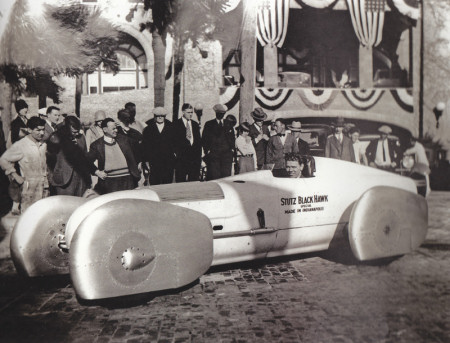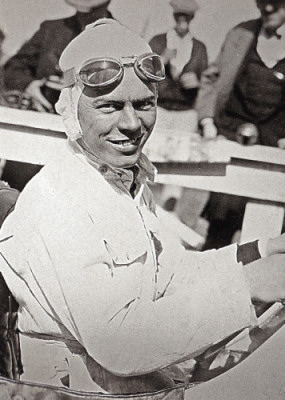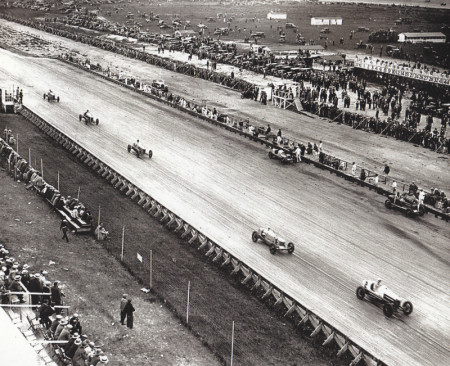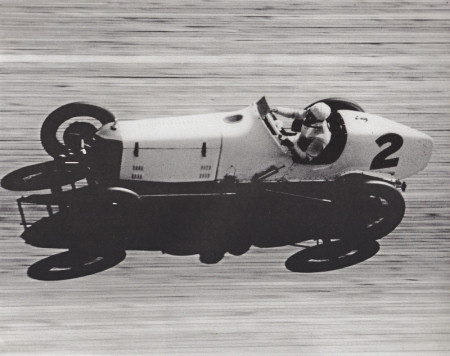The Way It Is/ Frank Lockhart, American Speed Kingby Gordon Kirby |
 Eighty-four years ago the Roaring Twenties were in full flight. The stock market was booming, money was on the land and American racing was enjoying what is often referred to as its Golden Age. Through the nineteen-twenties AAA Championship racing, Indianapolis aside, was dominated by high-banked board tracks and multi-car factory teams from Miller and Duesenberg. Big crowds turned out for the board track races in major urban centers of the flourishing nation and AAA Championship racing was one of the country's most popular sports with substantial coverage in all the major newspapers of the day.
Eighty-four years ago the Roaring Twenties were in full flight. The stock market was booming, money was on the land and American racing was enjoying what is often referred to as its Golden Age. Through the nineteen-twenties AAA Championship racing, Indianapolis aside, was dominated by high-banked board tracks and multi-car factory teams from Miller and Duesenberg. Big crowds turned out for the board track races in major urban centers of the flourishing nation and AAA Championship racing was one of the country's most popular sports with substantial coverage in all the major newspapers of the day.
In the midst of those halcyon days Tommy Milton set the land speed record on Daytona Beach in 1920 driving a twin-engined Duesenberg while Jimmy Murphy led the Duesenberg team to victory in the 1921 French Grand Prix before winning the following year's Indy 500 and the AAA national championship in '22 and '24. Before he was killed in September of 1924 in a dirt track race at Syracuse, NY, Murphy was known as the 'King of the Boards' in an era that produced many famous names including 1921 champion Milton, the USA's first three-time champion Earl Cooper, twice champion (1925 and '27) Pete dePaolo, 1923 champion Eddie Hearne, plus multiple race winners Harry Hartz and Leon Duray--all of them renowned national sports figures.  © Racemaker Press Lockhart designed and built a car known as the Stuz Blackhawk powered by a pair of Miller straight eights made into a supercharged V16. The car was tiny compared to most of its rivals like Malcolm Campbell's Bluebirds and Major Henry Segrave's Sunbeam and Goldenrod LSR cars. But Lockhart was able to challenge them, exceeding 200 mph on Daytona's narrow, sand beach before suffering a fatal crash when a tire failed during his record run on April 25, 1928--84 years ago last week. For the first time, the entire story of Lockhart's remarkable life and racing career has been told in 'Frank Lockhart, American Speed King' published recently by Racemaker Press. Written by renowned American racing historian Jim O'Keefe and Sarah Morgan-Wu the book tells the story of Lockhart's short life and career complete with a superb 160-page gallery of photographs, a thorough statistical section detailing all of Lockhart's races and record runs, and an equally thorough file of appendices. This is a scholarly and complete work brought vividly to life by the many beautiful full page photographs gracing the photo gallery. Born in Dayton, Ohio, Lockhart and his family moved to Los Angeles when he was ten. He went to high school in Inglewood and Pasadena and is father passed away just after his 17th birthday. It seems Frank didn't graduate from high school, going to work as an auto mechanic for a garage in Hollywood. He started his first race when he was 20 in the summer of 1923 driving what is believed to be his own Ford-based car called the 'Lockie Special' on a one-mile dirt track in San Luis Obispo.  © Racemaker Press Starting positions for the rare Ascot road race were determined by draw and Lockhart started 27th, more than two minutes behind polesitter 'Cannonball' Baker. But young Lockhart came through the field, going on to pass Baker for the lead and score an extremely popular victory. By then he was the star of Ascot with a fast-growing fan-following and reputation that earned him a ride for 1925 in Clarence Tarbet's 183 cubic inch Miller dirt car. Lockhart won his first race in Tarbet's car and by mid-summer he was hired by Harry Miller to race a factory Miller 122 with a 183 cid engine in west coast dirt track races. Miller also put Lockhart to work in his shop building his car and engine and in the second half of 1925 Lockhart won six of ten races he started for Miller.  © Racemaker Press The first four Championship races in 1926 were run to the old 122 cubic inch formula and Lockhart did not compete in any of these races. But early in May he was on the train to Indianapolis with the new 91 cid cars and the other drivers and mechanics on the Miller team. Near the end of the first week of practice Lockhart ran some laps in Benny Hill's car. Hill and Dave Lewis were Miller's lead drivers but Lockhart immediately lapped the big brick oval faster than Hill then duelled with Lewis for quick time of the week. In the end Lockhart set an unofficial track record and by then it was clear to all that the 23-year old Lockhart had plenty of talent. So when independent Miller driver Pete Kreis came down with the 'flu just before qualifying Kreis and Miller agreed that the boyish-looking Lockhart was the obvious choice to take over Kreis's car. His first qualifying run was flummoxed by a cut tire and a second attempt came to an end when his engine blew. Lockhart finally made the field on the last day of qualifying, running conservatively to qualify 20th in the middle of the seventh row. On raceday he quickly moved through the field, taking third on lap ten and passing Dave Lewis for the lead on lap 30. From there the remarkable rookie drove away from the field, ultimately winning by almost three laps from Harry Hartz when the race was cut short by rain after 160 laps or 400 miles. The kid from California had arrived. Miller immediately promoted Lockhart to his Championship team as a fulltime driver and Lockhart established himself as a major American sports star that summer as he won five more races and finished second to Harry Hartz in the AAA championship. Lockhart won more than $66,000 in 1926 which helped set him up as an owner/driver for 1927.  © Racemaker Press Among other things Lockhart and the Weisels designed and developed the world's first inlet manifold intercooler for the supercharged 91 cubic inch MIller engine and Lockhart was almost unbeatable in 1927. He won four of the year's 11 AAA Championship races and added five more dirt track wins although a second victory at Indianapolis eluded him. He qualified on the pole at the Speedway becoming the first man to break the 120 mph barrier at the track and ran away with the race until his engine blew after 120 laps. Although he won more races Lockhart finished second to Pete dePaolo in the AAA championship and at 24 years of age he set his mind to the wider goal of building a car to set the world land speed record. In those days Daytona Beach was famous for its land speed record runs. The era began in 1903 when Alexander Winton set a record for the flying mile of 68.198 mph and speeds began to increase rapidly after WWI when Ralph De Palma set a new standard of 149.875 mph in 1919 driving a V12 Packard and Tommy Milton pushed the mark up to 156.049 mph the following year driving a twin-engined Duesenberg. In 1922 Sig Haugdahl raised the mark to 180.27 aboard his 652 cubic inch eight-cylinder 'Wisconsin Special' before the British challengers Major Henry Segrave and Malcolm Campbell arrived with their British behemoths. Segrave became the first man to break the 200 mph mark in 1927 pushing his 2,738 cubic-inch twin V12 aero-engined Sunbeam to 203.792 mph. Meanwhile Lockhart was working flat-out on his Stutz Blackhawk assisted by the Weisel brothers and an all-star cast of mechanics and fabricators including Jean Marcenac, Myron Stevens and Floyd 'Pop' Dreyer. When he arrived in Daytona early in 1928 Lockhart was faced with plenty of competition from Malcolm Campbell's Bluebired powered by a 1,464 cubic inch Napier aero engine and Ray Keech's White Triplex with no fewer than three V12s displacing more than 5,000 cubic inches. Campbell set a new mark of 206.956 mph on February 19th with Keech pushing the standard to 207.552 mph on April 22nd.  © Racemaker Press Lockhart was only 25 when he died. His entire career spanned less than five years but in that short space of time he achieved more than many great drivers. Without doubt he is one of the greatest figures in American auto racing history and O'Keefe and Morgan-Wu's book puts it all into perspective. Any serious fan or student of the sport must have a copy of 'Frank Lockhart, American Speed King' in their library. The 256 page hardbound book includes 190 photos and costs $75.00 plus shipping and handling. To order the Lockhart book follow the link to Racemaker Press (www.racemaker.com). |
Auto Racing ~ Gordon Kirby Copyright 2012 ~ All Rights Reserved |
